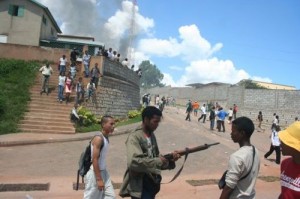2009 is coming to an end. It was, and still is, a tumultuous year [1] for Madagascar. The following article, which covers January to April, is the first of a three-part summary of the events that marked 2009, from the perspective of citizens who lived through the turmoil.
January:
As people started to protest in the streets of Antananarivo, many citizens quickly became aware that the looming political crisis was taking an unusual turn, as prison breaks were occurring [2] all around the country:
Jentilisa wondered about the cause of such unusual events [3] (mg):
Heverina ho misy ny atidoha nikotrika ny raharaha ary olona ivelan'ny voafonja ny atidoha, satria tsy tokony hanana finday na fitaovan-tserasera hafa ireo voafonja ireo handosirana tao
anatin'ny indray alina. Tarataratra ho fitadiavana hanakorontanana ny firenena amin'ny alalan'ny tsy filaminana no tanjona na fanindriana ankolaka ny olona tsy hihetsika satria hanampy isa ireo olona natao hanakorontana fotsiny (A qui profite le crime?). Hisy raharaha ity volana Janoary sy ny tohiny ity izany koa!
January turned out to be a deadly month [4]. Twitterers in Madagascar [5] spread news of Black Monday, the day security forces vanished and various incidents of arson and looting took place in the capital city [6], resulting in dozens of casualties. Jean, a member of a Yahoo! forum, asked [7]:
“Ny fanontaniana mipetraka sy tonga ho azy dia ny hoe inona moa no mahasamihafa ny zavatra potika amin'izao taona 2008 izao amin'izay zavatra potika tamin'ny taona 2002? … Ka inona ary no vaha-olana tsy hiverenan'ny fanapotehana intsony?”
February:
February 7th, remembered as “Red Saturday”, claimed the lives of at least 80 protesters, among them Ando Ratovonirina, a 26 year old cameraman for the television station RTA.

- Ando Ratovonirina, reporter for RTA killed on Feb, 7th (image from Foko-Madagascar)
Barijoana, one of the very first Malagasy bloggers, was a witness to the scene and wrote [9] (fr):
“J'étais persuadé que tout avait été négocié à l'avance, que la foule resterait gentiment à distance,
que seule une petite délégation entrerait à l'intérieur des grilles du palais et que c'est cette
délégation qui demanderait ensuite à la foule de se disperser.
J'étais trop loin pour savoir ce qui s'est passé dans la foule peu avant que le cordon de sécurité ne lâche. Si un responsable du mouvement a laissé entendre qu'on pouvait “y aller”, sa responsabilité est énorme.
Je ne peux parler que de ce que j'ai vu et entendu de mes propres yeux, mais ai trouvé étonnant que Andry Rajoelina et Monja Roindefo soient restés à l'écart des délégations négociant l'entrée dans les grilles du palais.”
It should be noted that the HAT (transitional government) promised a thorough investigation of the events that resulted in several deaths on January 26th and February 7th. To date, however, no official reports or conclusions have been made public, adding confusion to the contradicting testimonies from different sides.
March:
The crisis deepened as public protests dwindled, replaced by a rift in the armed forces. Ariniana posted on her twitter feed [10]:
“I feel like in a war movie. I can't believe it's real. I am damn terrified.”
Tahina illustrated vividly the climate of fear and mistrust that overcame everyone [11]:
It’s no longer safe to talk politics in public areas (buses included) because you don’t know who’s listening to you and on which side they are. A simple rumour about you can harm you or your relatives.
On March 17th, Andry Rajoelina, former mayor of Antananarivo and current president of the transition, seized power after a handover from the army. Understandably, opinions were divided on the coup d’etat and its future outcome. Madagate was satisfied that Ravaloamana was removed from power [12] (fr):
Marc Ravalomanana, le petit laitier d’Imerikasinina, a été renié par ceux à qui il venait de remettre les pleins pouvoirs. Ils n’ont pas voulu vendre leur âme au diable. Les carottes sont cuites pour ce président qui a montré son véritable visage. A force de jouer avec le feu et les idoles, on se brûle. Ce fut vraiment le combat de la lumière et des ténèbres.
Hery believed–rather accurately–that peace would not soon come to Madagascar [13], despite the change of regime:
Tsy resy lahatra aho amin'ny hilaminan'ny politika ao Madagasikara ao anatin'ny 2 taona farafahakeliny raha mandray fitondrana ny TGV [..] Hafa ny mitolona, ary hafa ny mitondra firenena.
April:
A video of a lone protester named Razily marching towards armed forces hurling tear gas became an internet sensation in Madagascar and was seen by many as the symbol of the fight against military repression:
The second part of this review will highlight bloggers’ posts from May to December 2009. In the meantime, please read Tahina's compelling testimony of the toll the crisis took on the life of one of his relatives [14]. Here is an excerpt:
For two or three months, I had to find money to make ends meet. It was hard as hell. The saying “You look for today what you’ll eat today” started to had a full sense to me. I was living it. I went to a uncle of mine to borrow some money and promised him I’d give it back as soon as possible. And I really wanted to keep my words but two months later, my wife was robbed in a bus with a-month-worth salary in her bag. I was hopeless, the little that I thought would help us was taken away from us.
